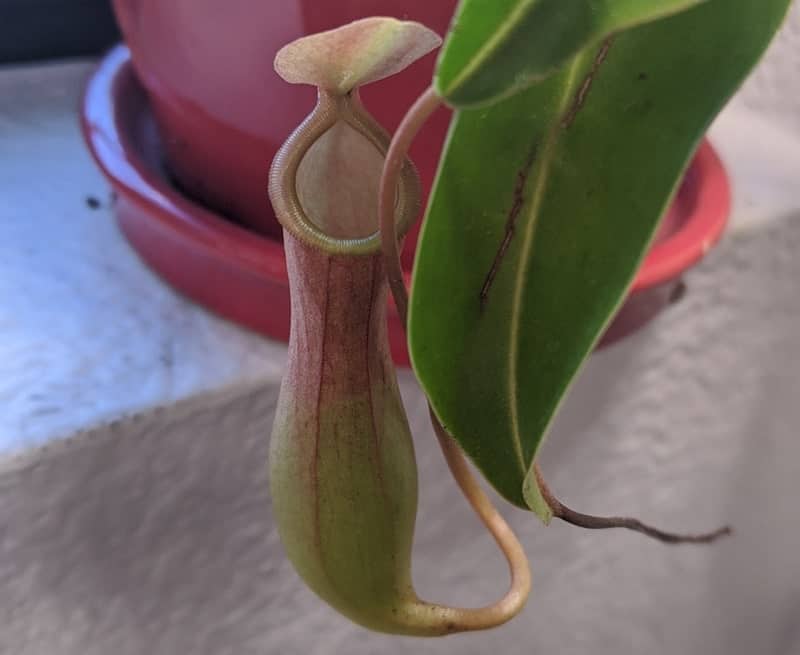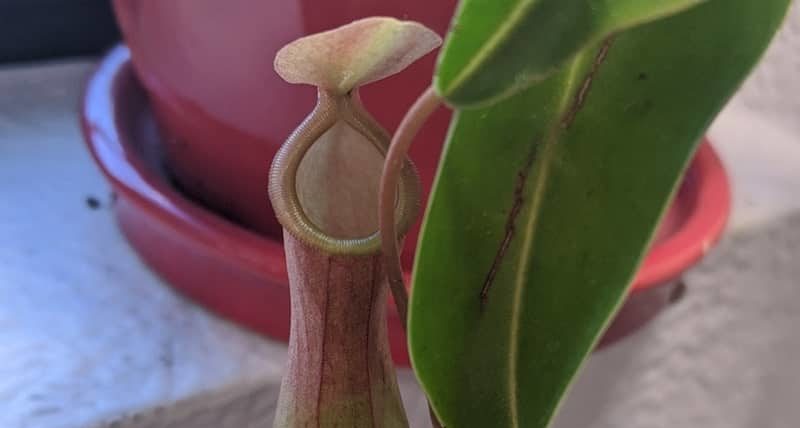Pitcher plants are unique carnivorous plants that characterize by pitcher like structures used to trap and consume insects. Inside the pitchers, there is a liquid, Pitcher plant water. Is Pitcher plant water safe?
Pitcher plant water is safe to drink as it poses no harm to humans. Pitcher plant water is made up of a mixture of rainwater and digestive substances produced by the plant. Some believe Pitcher plant water has medicinal properties; however, this has not been proven.
Before owning a Pitcher plant, I did tons of research to learn about their care and if they were safe to grow at home (this article I wrote expands on how safe are pitcher plants) (this article I wrote expands on how safe are pitcher plants). Keep on reading to get all the details on Pitcher plant water, including safety considerations for humans and pets.
Can You Drink Pitcher Plant Water?
Pitcher plant water is safe for human consumption. So, what happens when you drink the Pitcher plant water? One of the most frequently asked questions is if someone can drink the Pitcher plant water. Of course, yes!
Pitcher plant water has a neutral pH of 7.0, and after tasting, it tasted just like ordinary rainwater, and most likely, much of its water is rainwater.
Pitcher plants are harmless to humans and pets. Dogs and cats can be attracted to Pitcher plants due to their unique shapes and bright colors. A pet could eat a Pitcher plant without any dangerous health risk beyond a stomachache.

Some people say drinking pitcher plant water is likely to cause endless racy dreams. Taking Pitcher plant fluids through the mouth under the guidance of a doctor can be used as an alternative medicine for treating some unitary track complications, treatment of constipation, fluid retention problems, and digestion problems. However, there is no scientific proof of the Pitcher plant effectively treating the above conditions.
What Liquid Do Pitcher Plants Produce?
The small amount of liquid found within the Pitcher plant traps is known as phytotelmata, and it is usually for trapping insects.
Pitcher plants are carnivorous plants meaning that they feed on animals (insects). The fluid inside their traps is extremely viscous to effectively drown insects whose bodies are slowly dissolved through bacteria activities.
Pitcher plants contain special jug-shaped leaves that produce pitcher fluids to attract, trap, and digest small insects. Unopened pitcher leaves contain water that harbors bacteria that help digest trapped insects.
These carnivorous plants, mainly of the genus Nepenthes, depend on nutrients gotten from ingesting small insects after trapping using the pitcher-shaped leaves and digesting them using the enzymatic fluids.
Pitcher plants exhibit a wide diversity of prey, but their trapping mechanism is the most astonishing thing about them. For instance, their pitches have a slippery inner surface, which is not only easy to wet but also waxy for helping trap the insect firmly. However, not all species manifest this epidermal specialization but still very effective in trapping insects.
The physical properties of this digestive fluid play a critical role in holding the insect in the trap. For instance, even after the dilution by rainwater, its trapping efficiency doesn’t change. However, in the heavy rainy season, some of this viscous liquid is washed or diluted by rainfall.
What Happens When You Touch Pitcher Plant Water?
Although Pitcher plants have the predatory abilities to trap and digest small animals and insects, none of these Pitcher plants is man-eating.
Since the Pitcher plant water contains no harmful chemicals that could otherwise cause harm to your fingers, touching has no negative impacts on your fingers, but this may cause damage to your plant when it tries to fold on a relatively large object.
Once the prey sits on the leaf’s surface, the stiff hard surrounding the leaf blade automatically interlock, thus trapping the prey into tubular enclosing containing the digestive enzymes and fluids. The leaves of pitcher plants secrete sticky fluid substances that coat the inner surface of the pitchers.
Although your finder won’t fall prey to Pitcher plants, especially of the family Nepenthes, the only concern is the sickening substance that some plant members induce to foreign objects as a defense mechanism.
Can Drinking Pitcher Plant Water Save You in an Emergency?
Although the water from a pitcher plant is typically the ordinary water we drink, some Borneo and Sumatra legends say that drinking water from the pitcher plant has the ability to heal some illnesses. However, this isn’t scientifically proven, and therefore is important you get a go-ahead signal from your doctor to drink this water.
Since Pitcher plant fluid is just like the normal rainwater, it can save a life of an extremely thirst person, say in a remote area/ heavy jungle where someone can’t find clean water to drink.
An extremely dehydrated person, say in the jungle, and has no other feasible source of clean water will opt to drink the Pitcher water rather than perish from thirst. However, this should be only on extremely exceptional cases; otherwise, no need to risk your life so much experimenting with funny theories.
Gardening Tips for Growing Pitcher Plant at Home
Since Pitcher plants are safe to own, you might want to consider owning one. This section includes some beginner advice for choosing and caring for Pitcher plants.
Under the scientific study of Pitcher plants such as their structure, classification, how they grow, and their significance in the ecosystem, Pitcher plants are categorized as carnivorous plants. Native Pitcher plants members fall under the Nepenthaceae family of the order Caryophyllales while the Recent Pitcher plant members under the family Sarraceniaceae of order Ericales.
Although Pitcher plants’ appearance resembles that of exotic plants, you can grow several plant varieties in your compound. The plants have leaves resembling tubes that contain fluids for trapping small animals and insects.
Today, people grow pitcher plants indoors or outdoors. Some of the common pitcher plant genus are the Nepenthes, Sarracenia, and Darlingtonia.
Growing pitcher plants is easy, but you must ensure to follow all the key items. Start by researching the type of species suitable for your region or that can easily adapt to the local climate. It would be best if you kept your pitcher plant wet otherwise, you can grow it in a water garden. Note that moist and boggy soils can improve its performance. Besides, these plants perform well in full sun to partial shade light, and their optimum temperature ranges from 65 to 70 F.
Remember, it is important to mist their environment regularly and keep your plant near a humidifier; it may stop producing pitchers when the humidity drops past 40 percent and feed your indoor plant, especially at the start of your growing season.
If you are interested in growing Pitcher plants or other carnivorous plants, start by researching their care. Carnivorous plants have precise requirements. Implementing them is not difficult but critical. I wrote this article on carnivorous plant care to give you all the information you need to get started.


